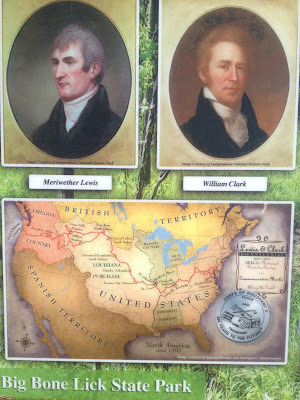 Perhaps 425 millions ago a meteorite nearly a half a mile in diameter slammed into the earth between present day cities of Shelbyville and Frankfort, Kentucky. The giant interplanetary traveler was traveling at an estimated speed of 10 miles per second. That is roughly 36,000 miles per hour! Needless to say, something the size of a small Kentucky town hitting the earth at such a speed was bound to leave an impact and that it did.
Perhaps 425 millions ago a meteorite nearly a half a mile in diameter slammed into the earth between present day cities of Shelbyville and Frankfort, Kentucky. The giant interplanetary traveler was traveling at an estimated speed of 10 miles per second. That is roughly 36,000 miles per hour! Needless to say, something the size of a small Kentucky town hitting the earth at such a speed was bound to leave an impact and that it did. |
| Jeptha's Knob near Clay Village in Shelby county Ky |
.JPG)  |
 |
| View of Middlesboro impact crater |
 Though there have been several reported meteorite impacts with some recovered in Kentucky none compare to these large impacts from ancient times which include one more near Versailles, Kentucky. Here we find yet another impact site that for years was mistaken to be the remnants of a large sinkhole, something not uncommon in the central Kentucky region. As it turns out this is the ancient remains of another meteorite impact similar to Jeptha's Knob.
Though there have been several reported meteorite impacts with some recovered in Kentucky none compare to these large impacts from ancient times which include one more near Versailles, Kentucky. Here we find yet another impact site that for years was mistaken to be the remnants of a large sinkhole, something not uncommon in the central Kentucky region. As it turns out this is the ancient remains of another meteorite impact similar to Jeptha's Knob.Not doubt there have been others that have long ago succumbed to erosion and time. However, we do have evidence that we have been hit before and it has been a long time.
What if one of those ancient meteorites contained precious metals such as say, oh, perhaps silver. Suppose it impacted the earth in some remote place and suppose our legendary John Swift happened to find that heavenly treasure. Of course, there is no evidence what so ever that has happened or even could happen. It does prove however, that pure sedimentary geological activity is not all that has happened in the amazing landscape we call Kentucky.
We are now in the fourth year of this blog. There have been thousands of visits to the blog site from around the world. I appreciate very much the valuable time that everyone took to visit and look at this blog site. I am especially grateful to those that subscribe and follow.
As I have noted many times before, I started this blog site to promote my now not so recent book entitled 'Swift." My aim was and has been to connect real places and subjects related to the book and special history of Kentucky. As time progressed I found myself covering a lot of interesting topics.
Keeping a blog up and running requires a lot of time and work as any of you know that maintain your own blog site. It is enjoyable and keeps me constantly searching for new adventures and ideas around the state. In recent months the blog seems to have done little to generate book sales, which after all, was my main objective.
With that in mind I plan to take a break from the regularly scheduled bi-monthly posts. Instead, for the time being I will randomly post articles. This will be the last post for a time. Besides this blog I am involved with another one called B and E's Bee's that is associated with our excellent honey we sell.
This blog site will remain live and active. With hundreds of visits each week the blog is popular, especially with treasure hunters. I will respond to comments and will post in the future as well as monitor the site.
With all that said this entry will mark the last one as I go on break from posting for now. Please share the contents of this blog to others. Thank you for visiting. Oh, the book is still available at most outlets.











.JPG)










